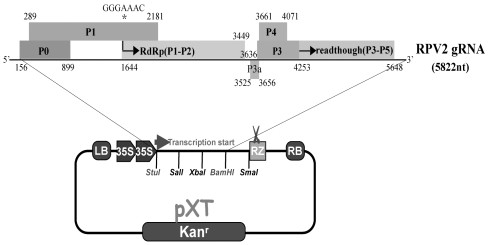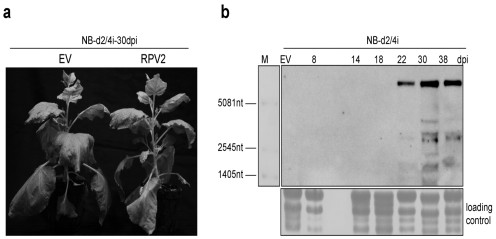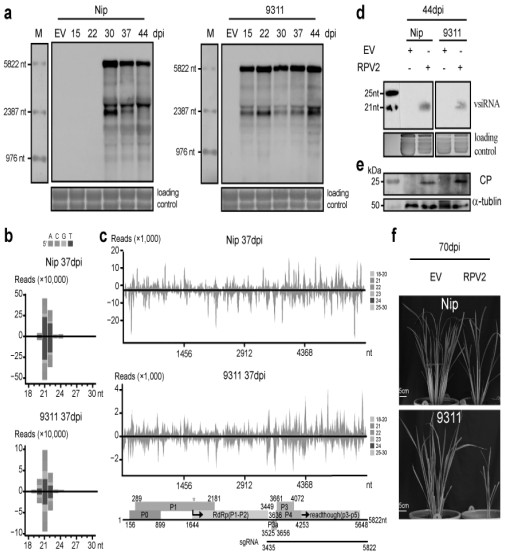Rice potato leaf roll virus 2 infectious clone as well as construction method and application thereof
A leaf-roll virus and a construction method technology, applied in the field of plant genetic engineering, can solve the problems of inability to use rice, little research on positive single-stranded rice virus, and complex structure.
- Summary
- Abstract
- Description
- Claims
- Application Information
AI Technical Summary
Problems solved by technology
Method used
Image
Examples
Embodiment 1
[0031] Example 1 Determination of the complete genome sequence of rice potato leaf roll virus 2 (RPV2)
[0032] 1. Extraction of plant total RNA
[0033] The total RNA of the leaves of wild rice with poison was extracted by the TRIzol method, and the extraction method was referred to the instructions of the plant RNA extraction kit.
[0034] Put about 0.1 g of leaves into a 2.0 centrifuge tube containing steel balls, grind them into powder under liquid nitrogen using a plant tissue grinder, then quickly add 1 mL of TRIzol, shake vigorously for 30 s, incubate at room temperature for 5 min, and then add 0.2 ml Chloroform, shake vigorously for 30 s, incubate at room temperature for 5 min, centrifuge at 12,000 g for 15 min at 4°C, take the upper aqueous phase into a new centrifuge tube, add an equal volume of isopropanol, invert and mix, and let stand at -20°C for 10 minutes. -30 min, 4°C, centrifuge at 12000g for 10 min, remove the supernatant, wash the precipitate twice with 75...
Embodiment 2
[0037] Example 2 Construction of wild rice virus infectious clone
[0038] Using the plasmids pTOPO-A1 and pTOPO-A2 correctly sequenced in Example 1 as templates, the complete nucleotide sequence of RPV2 was amplified in two sections with primer pairs XT001F / RPV2-3267R and RPV2-3248F / XT3R; then, CloneExpress®MultiS The One Step Cloning Kit Recombinant Cloning Kit (Nanjing Novizan Biotechnology Co., Ltd.) combines the purified amplified target fragment with the Stu I and Bam The HI linearized pXT vector was used for the recombination reaction, and a 10 μL system was used for the reaction, including 2 μL of 5×CE MultiS Buffer, 1 μL of Exnase MultiS, 90 ng of the linearized cloning vector pXT, and primer XT001F / RPV2-3267R. The target fragment 2 obtained from fragment 1 and RPV2-3248F / XT3R is about 65 ng and 50 ng, respectively, ddH 2 O was adjusted to 10 μL, and the components were mixed gently and reacted at 37 °C for 30 min. After the reaction was completed, it was placed on...
Embodiment 3
[0039] Example 3 pXT-RPV2 invasive clone inoculation
[0040] 1. Bunsen cigarette vaccination
[0041] First, a single colony of Agrobacterium GV3101 containing plasmid pXT-RPV2 was picked and inoculated in LB medium containing resistance to kanamycin (Kan, 50 mg / L) and rifampicin (Rif, 50 mg / L) 28 Activated by shaking overnight at ℃; the next day, the activated bacterial solution was transferred to the desired liquid LB at 1:100 (except for containing 50 mg / L Kan+Rif, additionally added 10 mM MES pH 5.6, 45 mM acetosyringone), 28° C culture OD 600 to 0.8-1.0; finally, 4000 rpm / min, room temperature, centrifugation for 10 min to collect the bacteria; with a final concentration of 10 mM MgCl 2 , 10 mM MES (pH 5.6), and 150 µM acetosyringone (As) buffer to resuspend, adjust the bacterial concentration to OD 600 0.8-1.0 was used for infection after at least 3-4 h at room temperature in the dark. Use a 1 mL syringe to suck up the Agrobacterium solution to be used, remove the n...
PUM
 Login to View More
Login to View More Abstract
Description
Claims
Application Information
 Login to View More
Login to View More - R&D
- Intellectual Property
- Life Sciences
- Materials
- Tech Scout
- Unparalleled Data Quality
- Higher Quality Content
- 60% Fewer Hallucinations
Browse by: Latest US Patents, China's latest patents, Technical Efficacy Thesaurus, Application Domain, Technology Topic, Popular Technical Reports.
© 2025 PatSnap. All rights reserved.Legal|Privacy policy|Modern Slavery Act Transparency Statement|Sitemap|About US| Contact US: help@patsnap.com



